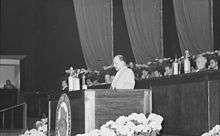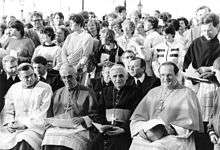Christianity in East Germany
The situation of Christianity in East Germany was characterised by an ongoing marginalisation of the influence of organised religions by the Communist government of East Germany.
State policies

On 5 June 1945, following the end of World War II in Europe, Soviet authorities established the Soviet occupation zone within Germany, installing a provisional government for the former Prussian provinces of Brandenburg, Saxony and the western part of Pommerania, as well as for the Länder of Mecklenburg, Saxony, Thuringia and Anhalt. Political parties that had been forbidden in Nazi Germany were allowed to resume their activities in 1945, including the Communist Party of Germany led by Walter Ulbricht, the Social Democratic Party of Germany, the Christian CDUD and the liberal LDPD. The first two parties merged into the Socialist Unity Party of Germany (SED) in 1946, which won the first regional elections and gradually managed to erode the significance of the other parties. The SED party congress formed a Popular Council in 1948, which declared itself a provisional parliament on 7 October 1949, adopted a constitution and proclaimed the German Democratic Republic (GDR) on the same day. In the years after that, the GDR quickly evolved into a de facto single-party socialist state.[1]
During the second party congress (9–12 July 1952), the SED abandoned its previously pronounced neutrality towards the churches. The announced "construction of socialism" (Aufbau des Sozialismus) required an "intensification of the class struggle" (Verschärfung des Klassenkampfes), including an offensive against the power of the churches. For example, Erich Mielke ordered a encompassing surveillance "of the churches and affiliate organisations such as the CDU" by the Ministry for State Security, because these "reactionary groups of people" were allegedly opponents of the construction of socialism. Arrests and convictions were already underway.[2] In a famous 10 October 1957 speech in Sonneberg, Ulbricht stated that old traditional beliefs should be thrown overboard.[3]
The GDR state sponsored atheism and tried to reduce the influence of the churches on society.[4] The GDR's constitution ostensibly proclaimed the freedom of religious belief, while "Freedom of religion and liberty of conscience did not in reality exist, and the exercise of religion was obstructed in every conceivable way".[5]
Protestantism
At the start of the German Democratic Republic, most of the people on its territory were Protestants. With exception of the Eichsfeld, a small Catholic area in the northwestern part of Thuringia, which was a former property of the archdiocese of Mainz, Catholics were a small minority right from the start of Communist rule.
See also
- Evangelical Church of the Union / Evangelische Kirche der Union (EKU); sections Postwar and Into the 1950s
Catholicism

(left to right) Bishop Karl Lehmann and Cardinals Gerhard Schaffran, Joseph Ratzinger and Joachim Meisner.
Right after the war, many Catholic parishes were cut off from their dioceses in the western part of Germany.
Since the 16th-century Protestant Reformation, Catholics had been a minority on the territory that became East Germany after the war.[6] Due to the post-war flight and expulsion of Germans from Eastern Europe to the west of the new Oder–Neisse line, refugees who resettled in East Germany increased the portion of Catholics between 1945 and 1949 to 13.9%.[6] Between the establishment of the GDR in 1949 and the construction of the Berlin Wall in 1961, about 1.1 million Catholics left the GDR.[6] From 1961 to 1988, their number shrunk further to 1.05 million Catholics, about 6% of the population.[6]
See also
References
- ↑ Encarta-encyclopedie Winkler Prins (1993–2002) s.v. "Duitse Democratische Republiek. §3.1 1945–1949". Microsoft Corporation/Het Spectrum.
- ↑ Dienstanweisung Mielkes vom 17. September 1952. In: Gerhard Besier, Stephan Wolf (ed.): Pfarrer, Christen und Katholiken. Das Ministerium für Staatssicherheit der ehemaligen DDR und die Kirchen. Neukirchen-Vluyn 1991, p. 150f.
- ↑ Die DDR im Rückblick: Politik, Wirtschaft, Gesellschaft, Kultur, Helga Schultz, Hans-Jürgen Wagener (ed.), Ch. Links Verlag, 2007, p. 61. ISBN 3861534401
- ↑ Deseret News National "During the decades of state-sponsored atheism in East Germany, more formally known as the German Democratic Republic, the great emphasis was on avoiding religion."
- ↑ Krisch, Henry, The German Democratic Republic. Westview Press, London, 1985, p. 153
- 1 2 3 4 Dr. Bernd Schäfer. "Kirchenpolitik und Säkularisierung in Ost und West". Zzf-pdm.de. Archived from the original on 2007-09-29. Retrieved 24 January 2018.